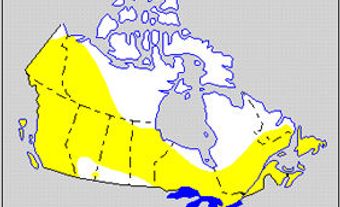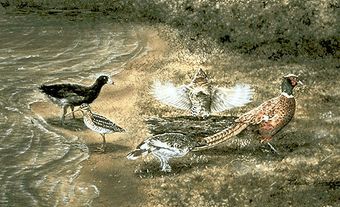Chickadees (genus, Poecile) are small birds, which live in woodlands throughout Canada, often visiting backyard birdfeeders. Both sexes have a dark cap and bib, which contrast against bright white cheeks. Chickadees do not migrate but spend the winter in small flocks foraging for insects and seeds. Social relationships in winter flocks follow a dominance hierarchy where high-ranking birds having preferential access to food. Other species of birds often join chickadee flocks, including nuthatches and woodpeckers.
Nesting
Chickadee flocks break apart when spring arrives, when pairs occupy breeding territories. Birds nest in cavities that they excavate in soft or rotten wood. Females lay large clutches of 5-7 eggs; the maximum clutch size reported for a chickadee is 13 eggs. Both parents contribute to feeding the nestlings with caterpillars and insects.
Song
Chickadees are named for their distinctive "chick-a-dee" vocalization. This call is highly variable and communicates a bird's motivation upon detecting a new source of food or a predator. Most chickadees have a species-distinctive song given by breeding males, as well as a variety of other vocalizations, some of which are understood to be as complex as human language.
Range and Habitat
There are 7 species of chickadee in North America, 5 of which breed in Canada. Black-capped chickadees (Poecile atricapillus) live in woodlands throughout Canada, and regularly visit backyard birdfeeders. Mountain chickadees (P. gambeli) and chestnut-backed chickadees (P. rufescens) are found in western Canada. Boreal chickadees (P. hudsonicus) live in the boreal forest throughout Canada. Although gray-headed chickadees (P. cinctus) breed in extreme northern Yukon and Northwest Territories, their Canadian populations are very remote. Carolina chickadees (P. carolinensis) and Mexican chickadees (P. sclateri) are only found south of Canada.
Taxonomy
Our understanding of genetic relationships within the tits (family, Paridae) has developed considerably with recent genetic studies. Formerly considered part of the same group, geneticists now distinguish the chickadee (genus, Poecile) from the titmouse (genus, Baeolophus) and various genera of European and Asian tits.

 Share on Facebook
Share on Facebook Share on X
Share on X Share by Email
Share by Email Share on Google Classroom
Share on Google Classroom





